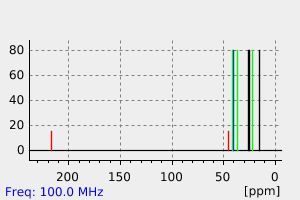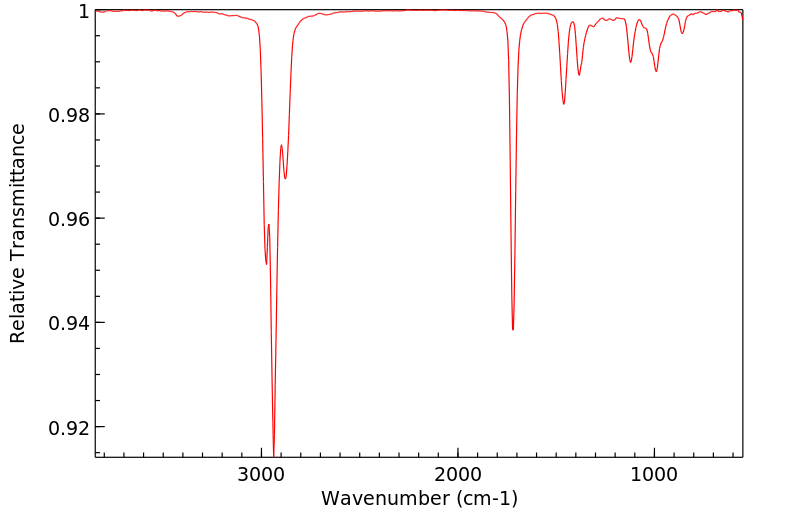2,2,6-三甲基环己酮 | 2408-37-9
中文名称
2,2,6-三甲基环己酮
中文别名
2,2,6-三甲基环庚烷
英文名称
2,2,6-trimethylcyclohexan-1-one
英文别名
2,2,6-trimethylcyclohexanone;2,6,6-trimethylcyclohexanone;2,6,6-trimethyl-cyclohexan-1-one
CAS
2408-37-9
化学式
C9H16O
mdl
MFCD00045550
分子量
140.225
InChiKey
ZPVOLGVTNLDBFI-UHFFFAOYSA-N
BEILSTEIN
——
EINECS
——
-
物化性质
-
计算性质
-
ADMET
-
安全信息
-
SDS
-
制备方法与用途
-
上下游信息
-
文献信息
-
表征谱图
-
同类化合物
-
相关功能分类
-
相关结构分类
物化性质
-
熔点:-31.8°C
-
沸点:178-179 °C(lit.)
-
密度:0.904 g/mL at 25 °C(lit.)
-
闪点:125 °F
-
溶解度:可溶于氯仿(少许)、甲醇(少许)
-
LogP:2.41
-
物理描述:Liquid
-
折光率:1.443-1.449
-
保留指数:1013;1008;1008;1019;1022;1011;1035;1017;1011;1019;1029;1016;1007;1012;1012
-
稳定性/保质期:
- 避免氧化物接触。
- 存在于烤烟烟叶、香料烟烟叶、主流烟气中。
计算性质
-
辛醇/水分配系数(LogP):2.4
-
重原子数:10
-
可旋转键数:0
-
环数:1.0
-
sp3杂化的碳原子比例:0.888
-
拓扑面积:17.1
-
氢给体数:0
-
氢受体数:1
安全信息
-
TSCA:Yes
-
危险等级:3
-
安全说明:S23,S24/25
-
危险类别码:R10
-
WGK Germany:3
-
海关编码:2914299000
-
包装等级:III
-
危险类别:3
-
危险品运输编号:UN 1224 3/PG 3
-
储存条件:请将容器密封,并将其存放在紧密封装的容器中,确保储存于阴凉、干燥的地方。
SDS
| Name: | 2 2 6-Trimethylcyclohexanone 98.5+% (GC) Material Safety Data Sheet |
| Synonym: | 2,2,6-Trimethylcyclohexan-1-one; Cyclohexanone, 2,2,6-trimethyl-; Trimethylcyclohexanon |
| CAS: | 2408-37-9 |
Synonym:2,2,6-Trimethylcyclohexan-1-one; Cyclohexanone, 2,2,6-trimethyl-; Trimethylcyclohexanon
Section 2 - COMPOSITION, INFORMATION ON INGREDIENTS
| CAS# | Chemical Name | content | EINECS# |
| 2408-37-9 | 2,2,6-Trimethylcyclohexanone (GC) | 98.5+ | 219-309-9 |
Risk Phrases: 10
Section 3 - HAZARDS IDENTIFICATION
EMERGENCY OVERVIEW
Flammable.The toxicological properties of this material have not been fully investigated.
Potential Health Effects
Eye:
May cause eye irritation. May cause chemical conjunctivitis and corneal damage.
Skin:
May cause irritation and dermatitis. May cause cyanosis of the extremities.
Ingestion:
May cause gastrointestinal irritation with nausea, vomiting and diarrhea. The toxicological properties of this substance have not been fully investigated. Ingestion of large amounts may cause CNS depression.
Inhalation:
May cause respiratory tract irritation. The toxicological properties of this substance have not been fully investigated. Aspiration may lead to pulmonary edema. Vapors may cause dizziness or suffocation.
May cause burning sensation in the chest.
Chronic:
No information found.
Section 4 - FIRST AID MEASURES
Eyes: Immediately flush eyes with plenty of water for at least 15 minutes, occasionally lifting the upper and lower eyelids. Get medical aid.
Skin:
Get medical aid. Flush skin with plenty of water for at least 15 minutes while removing contaminated clothing and shoes. Wash clothing before reuse.
Ingestion:
Never give anything by mouth to an unconscious person. Get medical aid. Do NOT induce vomiting. If conscious and alert, rinse mouth and drink 2-4 cupfuls of milk or water.
Inhalation:
Remove from exposure and move to fresh air immediately. If not breathing, give artificial respiration. If breathing is difficult, give oxygen. Get medical aid.
Notes to Physician:
Section 5 - FIRE FIGHTING MEASURES
General Information:
As in any fire, wear a self-contained breathing apparatus in pressure-demand, MSHA/NIOSH (approved or equivalent), and full protective gear. Vapors may form an explosive mixture with air.
Vapors can travel to a source of ignition and flash back. During a fire, irritating and highly toxic gases may be generated by thermal decomposition or combustion. Will burn if involved in a fire. Use water spray to keep fire-exposed containers cool. Containers may explode in the heat of a fire. Flammable liquid and vapor. Vapors may be heavier than air. They can spread along the ground and collect in low or confined areas.
Extinguishing Media:
Use water spray to cool fire-exposed containers. Water may be ineffective. Use agent most appropriate to extinguish fire. Do NOT use straight streams of water. Use water spray, dry chemical, carbon dioxide, or appropriate foam.
Section 6 - ACCIDENTAL RELEASE MEASURES
General Information: Use proper personal protective equipment as indicated in Section 8.
Spills/Leaks:
Cover with sand, dry lime or soda ash and place in a closed container for disposal. Remove all sources of ignition. Use a spark-proof tool. Provide ventilation. A vapor suppressing foam may be used to reduce vapors.
Section 7 - HANDLING and STORAGE
Handling:
Wash thoroughly after handling. Remove contaminated clothing and wash before reuse. Use only in a well-ventilated area. Ground and bond containers when transferring material. Use spark-proof tools and explosion proof equipment. Avoid contact with eyes, skin, and clothing. Empty containers retain product residue, (liquid and/or vapor), and can be dangerous. Keep away from heat, sparks and flame.
Avoid ingestion and inhalation. Do not pressurize, cut, weld, braze, solder, drill, grind, or expose empty containers to heat, sparks or open flames.
Storage:
Keep away from heat, sparks, and flame. Store in a tightly closed container. Store in a cool, dry, well-ventilated area away from incompatible substances. Flammables-area.
Section 8 - EXPOSURE CONTROLS, PERSONAL PROTECTION
Engineering Controls:
Facilities storing or utilizing this material should be equipped with an eyewash facility and a safety shower. Use adequate general or local explosion-proof ventilation to keep airborne levels to acceptable levels.
Exposure Limits CAS# 2408-37-9: Personal Protective Equipment Eyes: Wear appropriate protective eyeglasses or chemical safety goggles as described by OSHA's eye and face protection regulations in 29 CFR 1910.133 or European Standard EN166.
Skin:
Wear appropriate protective gloves to prevent skin exposure.
Clothing:
Wear appropriate protective clothing to prevent skin exposure.
Respirators:
A respiratory protection program that meets OSHA's 29 CFR 1910.134 and ANSI Z88.2 requirements or European Standard EN 149 must be followed whenever workplace conditions warrant respirator use.
Section 9 - PHYSICAL AND CHEMICAL PROPERTIES
Physical State: Clear liquid
Color: clear, colorless
Odor: None reported.
pH: Not available.
Vapor Pressure: Not available.
Viscosity: Not available.
Boiling Point: 61.0 - 62.0 deg C @ 15.00mm H
Freezing/Melting Point: Not available.
Autoignition Temperature: Not applicable.
Flash Point: 51 deg C ( 123.80 deg F)
Explosion Limits, lower: Not available.
Explosion Limits, upper: Not available.
Decomposition Temperature: Not available.
Solubility in water: Not available.
Specific Gravity/Density: .9040g/cm3
Molecular Formula: C19H16O
Molecular Weight: 260.33
Section 10 - STABILITY AND REACTIVITY
Chemical Stability:
Stable under normal temperatures and pressures.
Conditions to Avoid:
Incompatible materials, ignition sources, excess heat, strong oxidants.
Incompatibilities with Other Materials:
Strong oxidizing agents, strong reducing agents.
Hazardous Decomposition Products:
Carbon monoxide, carbon dioxide.
Hazardous Polymerization: Has not been reported.
Section 11 - TOXICOLOGICAL INFORMATION
RTECS#:
CAS# 2408-37-9 unlisted.
LD50/LC50:
Not available.
Carcinogenicity:
2,2,6-Trimethylcyclohexanone (GC) - Not listed by ACGIH, IARC, or NTP.
Section 12 - ECOLOGICAL INFORMATION
Section 13 - DISPOSAL CONSIDERATIONS
Dispose of in a manner consistent with federal, state, and local regulations.
Section 14 - TRANSPORT INFORMATION
IATA
Shipping Name: KETONES, LIQUID, N.O.S.*
Hazard Class: 3
UN Number: 1224
Packing Group: III
IMO
Shipping Name: KETONES, LIQUID, N.O.S.
Hazard Class: 3.3
UN Number: 1224
Packing Group: III
RID/ADR
Shipping Name: KETONES, N.O.S.
Hazard Class: 3
UN Number: 1224
Packing group: III
Section 15 - REGULATORY INFORMATION
European/International Regulations
European Labeling in Accordance with EC Directives
Hazard Symbols: Not available.
Risk Phrases:
R 10 Flammable.
Safety Phrases:
S 9 Keep container in a well-ventilated place.
S 16 Keep away from sources of ignition - No
smoking.
WGK (Water Danger/Protection)
CAS# 2408-37-9: No information available.
Canada
CAS# 2408-37-9 is listed on Canada's DSL List.
CAS# 2408-37-9 is not listed on Canada's Ingredient Disclosure List.
US FEDERAL
TSCA
CAS# 2408-37-9 is listed on the TSCA inventory.
SECTION 16 - ADDITIONAL INFORMATION
N/A
制备方法与用途
食品添加剂最大允许使用量与最大允许残留量标准
表格内容
| 添加剂中文名称 | 允许使用该种添加剂的食品中文名称 | 添加剂功能 | 最大允许使用量(g/kg) | 最大允许残留量(g/kg) |
|---|---|---|---|---|
| 2,2,6-三甲基环己酮 | 食品 | 食用药香料 | 用于配制香精的各香料成分不得超过在GB 2760中的最大允许使用量和最大允许残留量 | - |
请注意,上述信息中的“食品”一词重复列出,在实际应用中应予以修正。
上下游信息
-
上游原料
中文名称 英文名称 CAS号 化学式 分子量 2,2-二甲基环己酮 2,2-dimethyl-cyclohexanone 1193-47-1 C8H14O 126.199 2,2,6-三甲基-1,4-环己二酮 2,6,6-trimethyl-1,4-cyclohexanedione 20547-99-3 C9H14O2 154.209 二甲基环已酮 2,6-dimethyl-cyclohexanone 2816-57-1 C8H14O 126.199 2-甲基环己酮 2-Methylcyclohexanone 583-60-8 C7H12O 112.172 —— 2-chloro-2,6,6-trimethylcyclohexanone 13155-73-2 C9H15ClO 174.671 -
下游产品
中文名称 英文名称 CAS号 化学式 分子量 2,2,6,6-四甲基环己酮 2,2,6,6-tetramethylcyclohexanone 1195-93-3 C10H18O 154.252 —— (R)-2,2,6-trimethyl-cyclohexanone 106033-56-1 C9H16O 140.225 —— (S)-2,2,6-trimethyl-cyclohexanone 106036-02-6 C9H16O 140.225 2,4,4-三甲基-1,3-环己烷二酮 2,4,4-trimethylcyclohexane-1,3-dione 63184-86-1 C9H14O2 154.209 —— 2,2,6-Trimethyl-6-(β-cyan-ethyl)-cyclohexanon 16489-02-4 C12H19NO 193.289 —— 2ref,6trans-Dimethyl-2-<β-cyan-ethyl>-cyclohexanon 7647-22-5 C11H17NO 179.262 —— trimethyl-1-cyclohexanone 39257-08-4 C9H16O 140.225 —— (S)-2,2,6-trimethyl-6-(2-oxopropyl)cyclohexanone —— C12H20O2 196.29 —— (R)-2,2,6-trimethyl-6-(2-oxopropyl)cyclohexanone —— C12H20O2 196.29 —— (S)-2-allyl-2,6,6-trimethylcyclohexanone —— C12H20O 180.29 —— 2-Allyl-2.6.6-trimethylcyclohexanon 51417-26-6 C12H20O 180.29 —— 3-[(1S)-1,3,3-trimethyl-2-oxocyclohexyl]propanoic acid —— C12H20O3 212.289 —— 3-(1,3,3-Trimethyl-2-oxo-cyclohexyl)-propionsaeure 7647-46-3 C12H20O3 212.289 —— 2,6,6-Trimethyl-2-(4-chlorobut-2(Z)-enyl)-cyclohexanone 144340-78-3 C13H21ClO 228.762 2,2,6-三甲基环己烷甲醛 dihydro-cyclocitral 13155-57-2 C10H18O 154.252 —— 2-chloro-2,6,6-trimethylcyclohexanone 13155-73-2 C9H15ClO 174.671 6-羟基-2,2,6-三甲基环己酮 2-Hydroxy-2,6,6-trimethylcyclohexanone 7500-42-7 C9H16O2 156.225 —— 2-bromo-2,6,6-trimethylcyclohexanone 2816-63-9 C9H15BrO 219.121 - 1
- 2
反应信息
-
作为反应物:参考文献:名称:9-顺-视黄酸及其环脱甲基类似物的立体控制合成中的铃木偶联反应。摘要:enyl加速碘化四烯基碘化物19和环己烯基硼酸酯18的Suzuki偶联反应,可高产率获得9-顺式-视黄酸乙酯(12)。Suzuki反应的两个偶合伙伴在从其前体四烯基锡烷10和环己烯基碘13生成后,立即能更好地反应。在几何上均匀的四烯基锡烷10包括9-顺-视黄酸乙酯及其环脱甲基类似物的多烯侧链。由立体选择性霍纳-沃兹沃思-埃蒙斯反应合成。另一方面,容易获得的环己酮是制备合成环修饰的9-顺-视黄酸类似物所需的环己烯基硼酸酯的理想起始原料。对于受阻的环己酮,将azo酮转化为环己烯基碘化物。然后进行碘-锂交换并用B(OMe)(3)捕集,得到环己烯基硼酸酯。如果前体环己酮具有仲碳,则通过消除在用正丁基锂处理三甲hydr时获得的C,N-二甲硅烷基化的中间体(Shapiro反应)来方便地形成烯基锂物质。上述方法均不能使2-甲基环己酮生成更多取代的有机锂。但是,交替的34和10的Stille交叉偶联得到9DOI:10.1021/jo010711v
-
作为产物:描述:2,6,6-三甲基-2-环己烯-1,4-二酮 在 氢气 作用下, 以16%的产率得到2,2,6-三甲基环己酮参考文献:名称:Method for synthesis of 2,2,6-trimethylcyclohexan-1-one摘要:本发明涉及一种通过在气相中在氧化物催化剂存在下对2,6,6-三甲基-2-环己烯-1,4-二酮(酮异香叶酮,KIP)进行部分还原来合成2,2,6-三甲基环己烷-1-酮(TMCH)的方法。公开号:US20050027142A1
文献信息
-
Enantioselective Decarboxylative Alkylation Reactions: Catalyst Development, Substrate Scope, and Mechanistic Studies作者:Douglas C. Behenna、Justin T. Mohr、Nathaniel H. Sherden、Smaranda C. Marinescu、Andrew M. Harned、Kousuke Tani、Masaki Seto、Sandy Ma、Zoltán Novák、Michael R. Krout、Ryan M. McFadden、Jennifer L. Roizen、John A. Enquist、David E. White、Samantha R. Levine、Krastina V. Petrova、Akihiko Iwashita、Scott C. Virgil、Brian M. StoltzDOI:10.1002/chem.201003383日期:2011.12.9functions with nearly identical efficiency in terms of yield and enantioselectivity. Catalyst discovery and development, the optimization of reaction conditions, the exploration of reaction scope, and applications in target‐directed synthesis are reported. Experimental observations suggest that these alkylation reactions occur through an unusual inner‐sphere mechanism involving binding of the prochiral
-
Catalytic Allylic Oxidation to Generate Vinylogous Acyl Sulfonates from Vinyl Sulfonates作者:James K. Tucker、Matthew D. ShairDOI:10.1021/acs.orglett.9b00845日期:2019.4.5formation of vinylogous acyl sulfonates was accomplished via the allylic oxidation of the corresponding vinyl sulfonates. The reaction progressed through the agency of catalytic iron(III) chloride catalysis with tert-Butyl hydroperoxide (TBHP) as the stoichiometric oxidant. Tolerance of other functional groups, including some other allylic and benzylic sites, was observed.
-
[EN] OPSIN-BINDING LIGANDS, COMPOSITIONS AND METHODS OF USE<br/>[FR] LIGANDS DE LIAISON À UNE OPSINE, COMPOSITIONS ET PROCÉDÉS D'UTILISATION申请人:BIKAM PHARMACEUTICALS INC公开号:WO2013058809A1公开(公告)日:2013-04-25Compounds are disclosed that are useful for treating ophthalmic conditions caused by or related to production of toxic visual cycle products that accumulate in the eye, such as dry adult macular degeneration, as well as conditions caused by or related to the misfolding of mutant opsin proteins and/or the mis-localization of opsin proteins. Compositions of these compounds alone or in combination with other therapeutic agents are also described, along with therapeutic methods of using such compounds and/or compositions. Methods of synthesizing such agents are also disclosed.披露了一些化合物,可用于治疗由于或与在眼睛中积累的有毒视觉循环产物有关的眼科疾病,例如干性成人黄斑变性,以及由于或与突变视蛋白的错误折叠和/或视蛋白的错误定位有关的疾病。还描述了这些化合物单独或与其他治疗剂联合使用的组合物,以及使用这些化合物和/或组合物的治疗方法。还披露了合成这些药剂的方法。
-
[EN] INDANYLOXYDIHYDROBENZOFURANYLACETIC ACIDS<br/>[FR] ACIDES INDANYLOXYDIHYDROBENZOFURANYLACÉTIQUES申请人:BOEHRINGER INGELHEIM INT公开号:WO2012072691A1公开(公告)日:2012-06-07The present invention relates to compounds defined by formula (I) wherein the variables R1, R2, R3, m, and n are defined as in claim 1, possessing valuable pharmacological activity. Particularly, the compounds are activators of the receptor GPR40 and thus are suitable for treatment and prevention of diseases which can be influenced by this receptor, such as metabolic diseases, in particular diabetes type 2.本发明涉及具有式(I)定义的化合物,其中变量R1、R2、R3、m和n如权利要求1中定义,具有宝贵的药理活性。特别是,这些化合物是GPR40受体的激动剂,因此适合用于治疗和预防可以通过这种受体影响的疾病,例如代谢性疾病,特别是2型糖尿病。
-
Substituierte Propargylcarbinole und ihre hypnotische Wirkung作者:H. Gutmann、O. Isler、G. Ryser、P. Zeller、B. PellmontDOI:10.1002/hlca.19590420312日期:——Thirty tertiary propargylic carbinols have been prepared by condensing propargyl bromide with ketones. Some of them showed better hypnotic activity than 3-methylpentyn-3-01. The best compound of the series was 1-chloro-2-chloromethylpent-4-yn-2-01 which proved to be a very effective hypnotic with a favourable therapeutic index.
表征谱图
-
氢谱1HNMR
-
质谱MS
-
碳谱13CNMR
-
红外IR
-
拉曼Raman
-
峰位数据
-
峰位匹配
-
表征信息
同类化合物
(反式)-4-壬烯醛
(s)-2,3-二羟基丙酸甲酯
([1-(甲氧基甲基)-1H-1,2,4-三唑-5-基](苯基)甲酮)
(Z)-4-辛烯醛
(S)-氨基甲酸酯β-D-O-葡糖醛酸
(S)-3-(((2,2-二氟-1-羟基-7-(甲基磺酰基)-2,3-二氢-1H-茚满-4-基)氧基)-5-氟苄腈
(R)-氨基甲酸酯β-D-O-葡糖醛酸
(5,5-二甲基-2-(哌啶-2-基)环己烷-1,3-二酮)
(2,5-二氟苯基)-4-哌啶基-甲酮
龙胆苦苷
龙胆二糖甲乙酮氰醇(P)
龙胆二糖丙酮氰醇(P)
龙胆三糖
龙涎酮
齐罗硅酮
齐留通beta-D-葡糖苷酸
鼠李糖
黑芥子苷单钾盐
黑海棉酸钠盐
黑木金合欢素
黑曲霉三糖
黑介子苷
黄尿酸8-O-葡糖苷
麻西那霉素II
麦迪霉素
麦芽糖脎
麦芽糖基海藻糖
麦芽糖1-磷酸酯
麦芽糖
麦芽四糖醇
麦芽四糖
麦芽十糖
麦芽六糖
麦芽五糖水合物
麦芽五糖
麦芽五糖
麦芽五糖
麦芽三糖醇
麦芽三糖
麦芽三糖
麦芽三塘水合
麦芽七糖水合物
麦芽七糖
麦法朵
麦可酚酸-酰基-Β-D-葡糖苷酸
麦利查咪
麝香酮
鹤草酚
鸢尾酚酮 3-C-beta-D-吡喃葡萄糖苷
鸡矢藤苷









